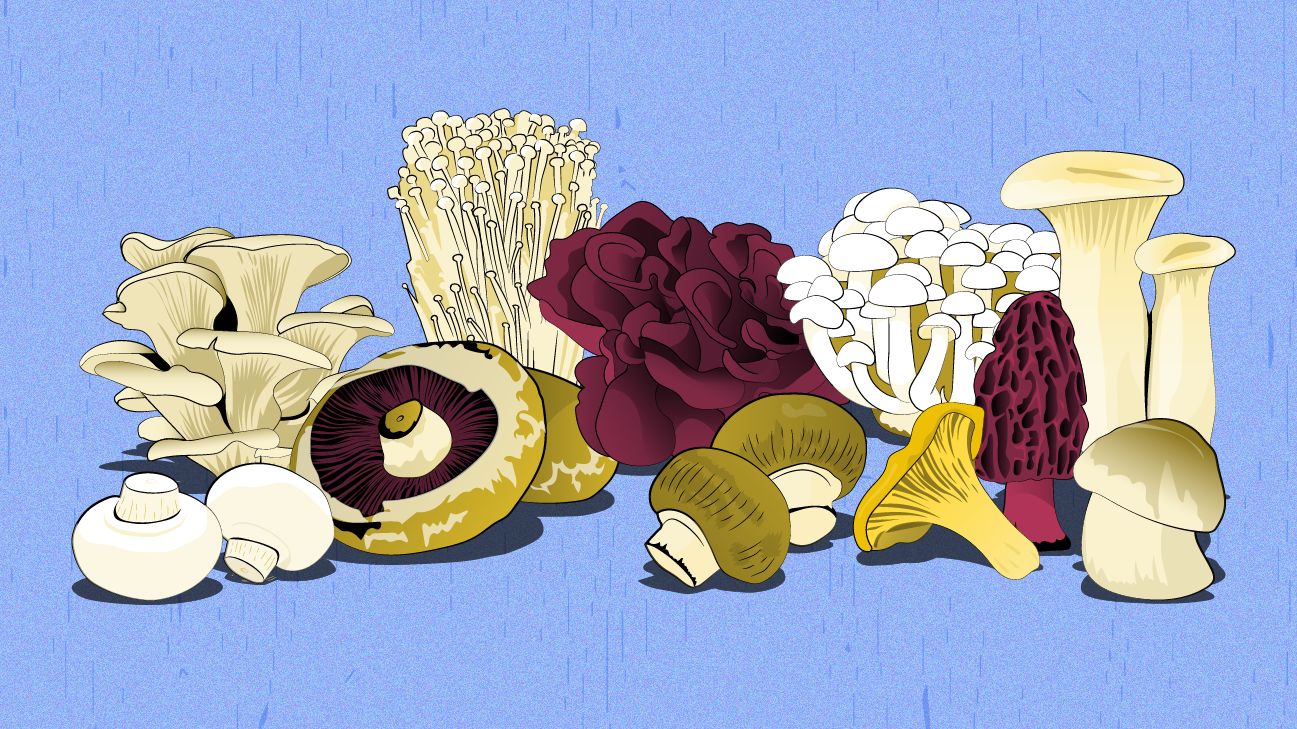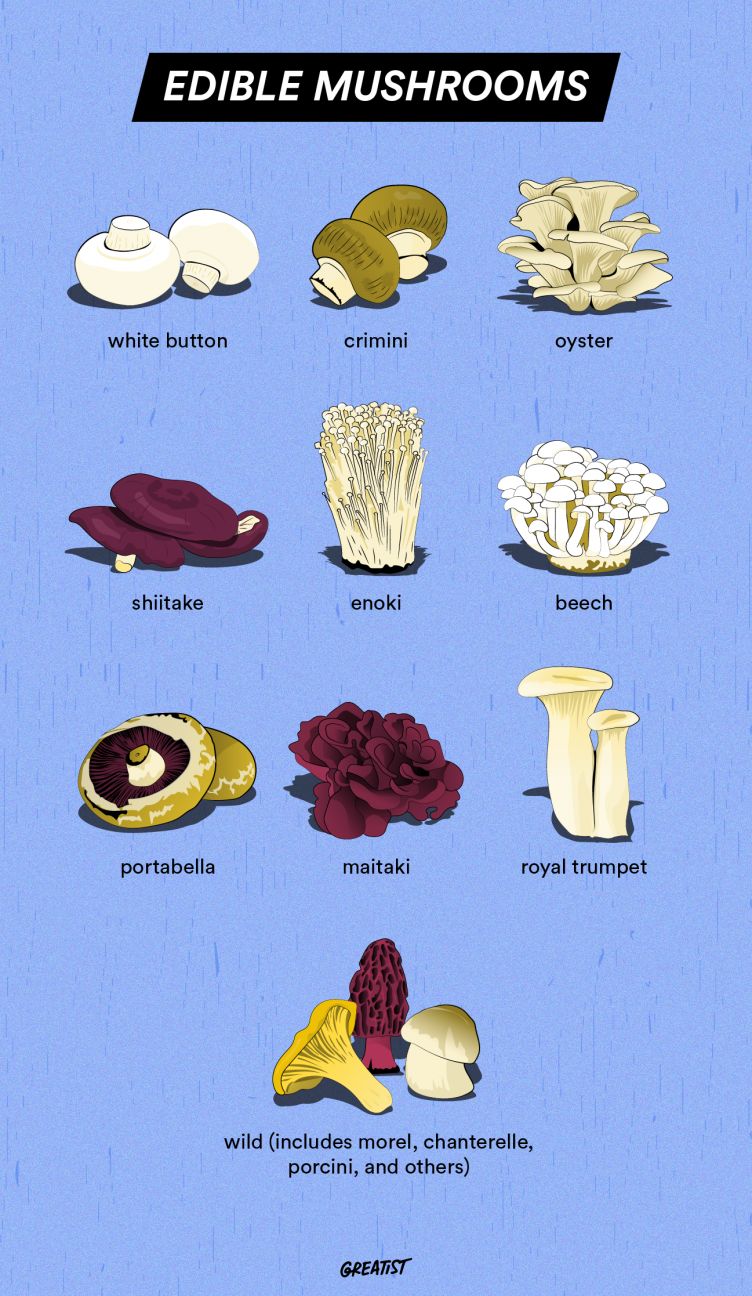If the words “edible mushrooms” make you think of psychedelic voyages of kaleidoscope colors and shapes, you’re not alone. But not every edible ’shroom will send you tripping (thank goodness!).
Of the approximately 14,000 species of mushrooms on the planet, many are simply delicious additions to soups, salads, sauces, casseroles, and plant-based burgers.
Mushrooms also happen to pack primo nutrition. They’re the only veggie source of vitamin D (and one of the few foods that naturally contain this micronutrient). Plus, they’re low in fat and carbohydrates and provide significant amounts of vitamins A, C, B6, and B12 and selenium,

10 Edible Mushrooms to Forage the Forest For
- white button
- cremini
- shiitake
- maitake
- oyster
- enoki
- beech
- portobello
- trumpet
- chanterelle
Ready to explore the world of fun guys (*wink*)? Here’s the lowdown on 10 tasty edible mushroom varieties.
These colorless little ’shrooms really are cute as a — well, you get the idea. It’s no surprise they’re the most popular mushroom in the United States, accounting for about 90 percent of national sales. Petite and mild, they bring chunky texture and a hint of earthy flavor to just about any meal.
Button mushrooms’ flavor intensifies with cooking, so get thee to a sauté pan! Try them in these easy Restaurant-Style Sautéed Mushrooms from Eating by Elaine or Caramelized Onion and Mushroom White Pizza from Budget Bytes.
One serving of five medium white button mushrooms contains 20 calories, 0 g fat, 3 g carbs, and 3 g protein.
Just as adorable as white buttons are their brown counterparts, cremini mushrooms (also spelled “crimini”). Aside from color, they have essentially the same appearance as white buttons. But they come with a deeper, more potent flavor.
Creminis complement meat especially well, so Instant Pot Beef, Barley, and Mushroom Soup from Yay for Food and One-Pot Beef Stroganoff from Damn Delicious are the perfect vehicles for their velvety texture.
One serving of four cremini mushrooms contains 18 calories, 0 g fat, 3 g carbs, and 2 g protein.

Holy shiitake! These East Asian natives have gained a following for their umami flavor, high fiber content, and antioxidant activity. You’ll recognize them by their broad brown caps and curved stems.
In recipes, shiitakes contribute meaty texture and earthy taste. Just be sure to remove their stems before eating, because they’re too tough to eat (though you can save them to make a savory broth!).
Wanna get busy with shiitakes in the kitchen? Check out Shiitake Mushroom Miso Soup from Aberdeen’s Kitchen, Creamy Chicken Mushroom Casserole from I Heart Umami, or Home-Style Tofu with Shiitake Mushrooms from Fat-Free Vegan Kitchen.
One serving of four shiitake mushrooms contains 26 calories, 0 g fat, 5 g carbs, and 2 g protein.
Call them maitake, hen of the woods, or sheep’s head — just don’t call them boring! These fungi grow in unique clusters that resemble the petals of a flower. Fans describe their taste as peppery, woodsy, or spicy.
Most recipes call for pulling the “petals” of maitake apart before cooking, but you can also grill or roast these mushrooms whole. Grilled Thai Marinated Maitake Mushrooms from Vegan in the Freezer or a Hen of the Woods ‘Steak’ from Hunter, Angler, Gardener, Cook can get you started.
A 1-cup serving of maitake mushrooms contains 22 calories, 0 g fat, 5 g carbs, and 1 g protein.
Oyster mushrooms have a unique history. First cultivated to stave off starvation in post-World War I Germany, they’ve since blossomed into a sought-after culinary treat all over the globe.
Their nautical name can be attributed to their rippled, fan-like caps, which resemble the flared body of an oyster.
Raw oyster mushrooms can have a slightly metallic taste, so you may enjoy them more when they’re cooked.
Creamy Pasta with Brown Oyster Mushrooms from Garlic Delight, Fried Oyster Mushrooms from Vegan with Curves, and Oyster Mushroom Tacos from Olives for Dinner are tasty options for these mild-flavored fungi.
One serving of six small oyster mushrooms contains 30 calories, 0 g fat, 5 g carbs, and 3 g protein.
Narrow and pencil-thin, with long stalks and itty-bitty heads, cultivated enoki mushrooms have a rather otherworldly look. These unique fungi grow in bundles of up to several dozen pale stalks, which you can separate by trimming them at the roots.
Enoki are known for their delicate flavor — like tofu, they’re a bit of a chameleon, taking on any flavor you apply. Crunchy when raw and tender when cooked (think al dente pasta), they’re versatile in broth bowls, stir-fries, and soups.
Looking for a starting point for your enoki? Check out this Kimchi Ramen from Street Smart Kitchen, Korean Enoki Mushroom Pancakes from My Korean Kitchen, or Garlic Butter Enoki Mushrooms from Low Carbing Asian.
One serving of 17 large enoki mushrooms contains 31 calories, 0 g fat, 7 g carbs, and 2 g protein.
Picture a cluster of fungi growing on a forest floor and you’ll probably get a mental image of beech mushrooms. Their small heads are typically dappled with light brown and/or white coloring, and they grow in “bouquets” of multiple stalks.
They’re also found growing on the sides of beech trees — hence their name (which is much easier to pronounce than their scientific classification, Hypsizygus tesselatus).
Beech mushrooms have a crispy crunch when eaten raw, but most people prefer their nutty, slightly sweet taste in cooked preparations. Sample them in Sautéed Asparagus with Mushrooms from Delightful Plate or a Vegan Mushroom Stir-Fry from Avocado Pesto.
A 57-gram serving of beech mushrooms contains 22 calories, 0 g fat, 4 g carbs, and 1 g protein.
Famous for their sturdiness and caps up to 6 inches in diameter, portobellos are the mushroom you’ll most likely see wedged between hamburger buns. And at just 19 calories per ’shroom, they’re a weight loss-friendly main dish if there ever was one.
But portobellos’ dimensions and calorie count aren’t the only factors that make them an ideal vegetarian burger alternative. Their meaty texture and smoky flavor might make you say “Big Mac who?”
Fire up the grill for this Portobello Mushroom Burger with Avocado Chimichurri from Foodie Crush or turn the caps upside down and stuff ’em to make these Quinoa and Sweet Potato Stuffed Mushrooms.
P.S. What’s the difference between portobello and portabella? Nothing, actually. They’re two names for the same food.
One whole portobello mushroom contains 19 calories, 0 g fat, 3 g carbs, and 2 g protein.
Bum-bada-ba! Blow the royal trumpet for these meaty mushrooms, often used as a vegan alternative to scallops. Also known as king oyster, king trumpet, or French horn mushrooms, they really do look like a brass instrument, with a medium-long stalk and a flared head.
Sample their sturdy texture and nutty flavor in Vegan Scallops from Veggie Society or Soy Butter Glazed King Oyster Mushrooms from The Woks of Life.
One serving (87 g) of royal trumpet mushrooms contains 30 calories, 0 g fat, 5 g carbs, and 3 g protein.
These pretty ‘shrooms look like seashells or flowers and go by the names pfifferling, golden, yellow, and egg mushrooms. These beauties are very difficult to cultivate, which is why they are best foraged for in the wild. You’ll find them all over the Pacific northwest.
Try them in a salad, omlette, or decadent risotto – mmm.
One serving (100 g) of chanterelle mushrooms contains 32 calories, 0 g fat, 6.86 g carbs, and 3.8 g protein.
Anyone who’s seen the movie “Phantom Thread” (or any other story in which an innocent eater munches wild mushrooms with disastrous results) may be wary of eating the uncultivated variety.
It’s true that many species of mushrooms that grow willy-nilly are poisonous. In fact, thousands of people accidentally consume toxic ’shrooms every year.
Take-home message: Don’t eat a wild mushroom unless you’re absolutely sure it’s been vetted for safety. The best way to do this is to procure your wild fungi from a trusted purveyor. Fortunately, plenty of wild mushrooms are now available at specialty (and even some chain) grocery stores.
If you do decide to “go wild,” you’ll find innumerable varieties to try. Common faves include chanterelles, porcinis, and morels.
Toss some of these flavorful fungi into this rich Vegetarian Wild Mushroom Gravy from Oh My Veggies, roast them in the oven with Roasted Mushrooms from Salt Pepper Skillet, or let Creamy Wild Mushroom Soup from Inside the Rustic Kitchen warm you from the inside out.

